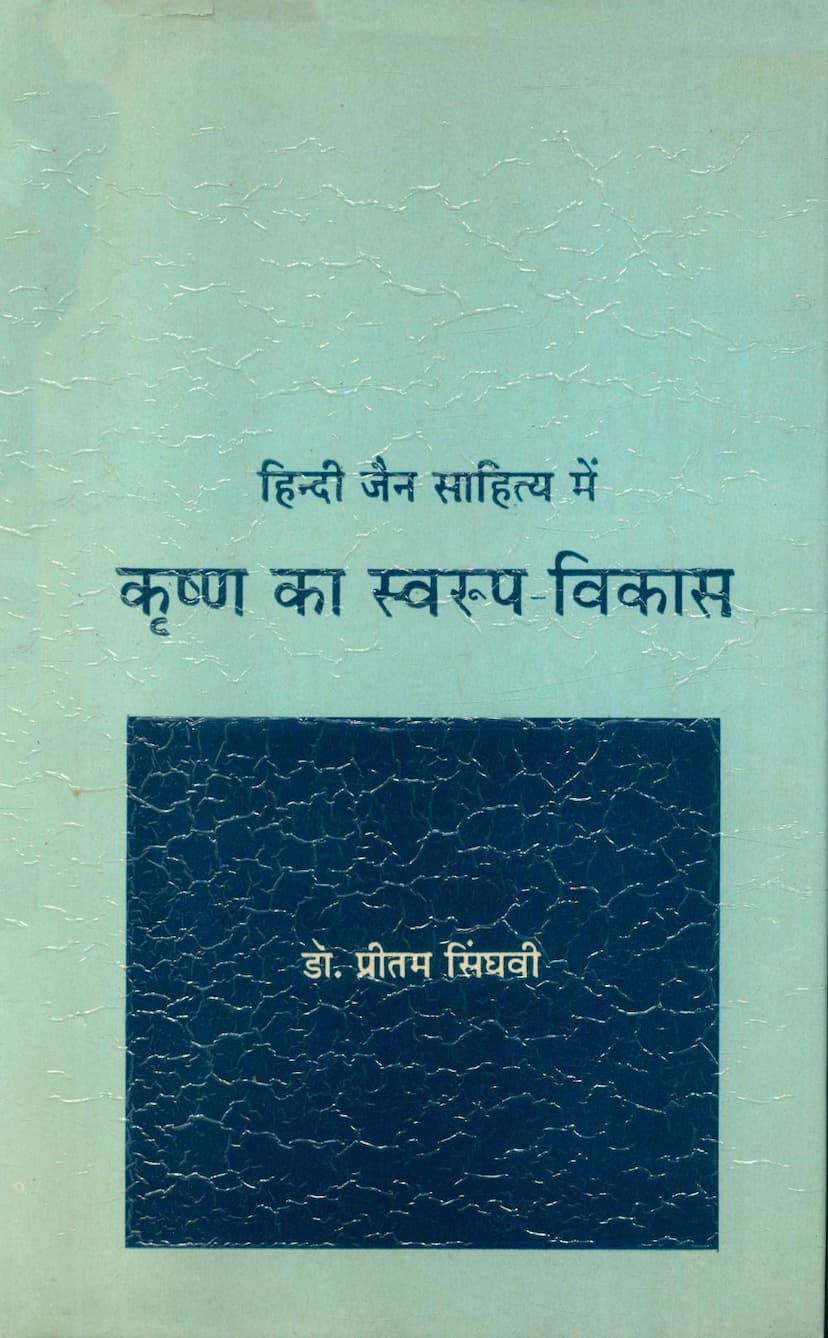Hindi Jain Sahitya Me Krishna Ka Swarup Vikas
Added to library: September 1, 2025

Summary
This book, "Hindi Jain Sahitya Me Krishna Ka Swarup Vikas" (The Development of Krishna's Image in Hindi Jain Literature) by Dr. Pritam Singhvi, is a scholarly work that examines the portrayal of Lord Krishna in Jain literature, particularly in Hindi. The book was accepted as a PhD dissertation by Gujarat University.
Here's a comprehensive summary based on the provided text:
Core Argument:
The central thesis of the book is to trace and analyze the evolution of Krishna's image within Jain literature, contrasting it with the traditional Vaishnava (Hindu) understanding. While Vaishnavism considers Krishna an avatar of Vishnu, Jainism views him as a Shalaka Purusha (a great being embodying humanistic virtues like beauty, love, kindness, valor, and compassion). The book demonstrates that Jain literature depicts Krishna as an अहिंसक (non-violent), विनयी (humble), क्षमाशील (forgiving), and शांतिदूत (messenger of peace). His romantic and diplomatic aspects are also acknowledged, though presented within the Jain framework.
Key Aspects of the Study:
- Comparative Approach: Dr. Singhvi meticulously compares Krishna's depiction across various literary traditions: Sanskrit, Prakrit, Apabhramsha, and Hindi Jain literature. This comparative approach allows her to highlight the unique Jain perspective.
- Jain Cosmology and Krishna: The book explains the Jain concept of Shalaka Purushas, which includes 24 Tirthankaras, 12 Chakravartis, 9 Vasudevas, 9 Baladevas, and 9 Prativasudevas. Krishna is identified as one of the nine Vasudevas in the current era (Avasarpini). The Jain perspective integrates figures recognized in broader Indian society, like Krishna and Rama, into their own system of great beings, even if they are not elevated to the status of Tirthankaras in the present cosmic cycle.
- Krishna's Virtues in Jain Literature: Jain literature emphasizes Krishna's adherence to non-violence, his humility, forgiveness, and role as a peace-bringer. His romantic and diplomatic sides are present but interpreted differently than in Vedic literature.
- Focus on Hindi Jain Literature: While acknowledging the earlier Jain traditions, the book's primary focus is on how Krishna's image developed and was presented in Hindi Jain literature. It highlights that much of this literature is unknown to the wider Jain community and the general public, with a significant portion remaining in manuscript form.
- Historical and Mythological Context: The study explores Krishna's historical, mythological, and religious aspects as portrayed in Hindi Jain literature, aiming to bring this often-overlooked material to light.
- Three Facets of Krishna in Jain Literature: The book analyzes Krishna through three main lenses:
- Yogi/Dharmatma (Spiritual/Righteous Person): Emphasizing his ethical and spiritual dimensions.
- Lalit/Madhur Gopala (Charming/Sweet Cowherd): Depicting his youthful and endearing aspects.
- Veer Shalaka Purusha (Valiant Great Being): Highlighting his strength, leadership, and heroism.
- Influence and Origins: Dr. Singhvi traces the origins of the "Krishna story" in ancient Indian literature, including Vedic texts (Rigveda, Upanishads), Mahabharata, and Puranas, to understand the background against which Jain writers developed their own narrative.
- Jain Narrative vs. Vedic Narrative: The book notes that while many core events of Krishna's life (like killing Kansa, establishing Dwarka, marrying Rukmini, and battles with Jarasandha) are shared between Jain and Vedic traditions, the Jain interpretation often aligns more with justice and logic from their perspective. They differentiate their Krishna from the divine or avataric figure of Vaishnavism. Notably, Jain texts often portray Krishna as influenced by his Jain Tirthankara cousin, Neminath (Arishtanemi), leading to his emphasis on non-violence and vegetarianism.
- Key Jain Texts and Authors: The study draws from various Jain texts and authors, including those who wrote in Prakrit, Apabhramsha, and Sanskrit, and subsequently influenced Hindi Jain literature. Specific mention is made of the impact of Jinadatta Suri, Hemachandra, Pushpadanta, and others on the narrative traditions. The book also discusses Hindi Jain works like Harivansha Purana by Shali Vahana and Khushal Chand Kala.
- Emphasis on Purity and Rationality: The preface and acknowledgments suggest the book aims for a neutral and scholarly analysis, aiming to illuminate a less-explored area of literature. The work is praised for its originality and potential to open new avenues for studying Krishna literature.
Structure of the Book (as indicated by chapter headings):
- Chapter 1: Emergence and Development of Krishna's Image in Ancient Literature: This chapter likely sets the stage by tracing Krishna's presence and evolving portrayal from Vedic times onwards.
- Chapter 2: The Nature, Outline, and Major Events of Krishna's Story in Hindi Jain Literature: This section focuses on the specific narrative found in Hindi Jain texts, outlining key events and the overall structure of the story.
- Chapter 3: Description of Krishna's Image in Hindi Jain Literature: This chapter delves into the specific attributes and characteristics attributed to Krishna within the Hindi Jain literary corpus.
- Chapter 4: Comparison of Krishna's Image Development from Vedic Period to Modern Times in Vaishnava Literature and its Development in Hindi Jain Literature: This comparative chapter directly addresses the core thesis by juxtaposing the two traditions.
- Appendices: Including a bibliography of reference texts.
In essence, Dr. Pritam Singhvi's book provides a vital and scholarly exploration into the distinct and nuanced representation of Lord Krishna within the Jain tradition, particularly as it manifested in Hindi literature, highlighting his role as a great human being and a spiritual leader rather than a divine incarnation.